M1117 Armored Security Vehicle
The M1117 Guardian, also denoted Armored Security Vehicle (ASV), is an internal security vehicle based on the V-100 and V-150 Commando series of armored cars. It was developed in the late 1990s for service with the United States Military Police Corps.[2] The first prototypes appeared in February 1997 and serial production of the M1117 commenced between 1999 and early 2000.[2]
| M1117 Armored Security Vehicle | |
|---|---|
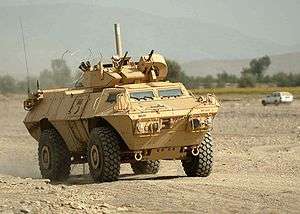 A U.S. Army M1117 Armored Security Vehicle in Khost Province, Afghanistan in September 2007 | |
| Type | Internal security vehicle |
| Place of origin | United States of America |
| Service history | |
| In service | 1999–present |
| Used by | See Operators |
| Wars | War in Afghanistan Iraq War Iraqi insurgency (2011–present) Colombian Conflict Syrian Civil War[1] |
| Production history | |
| Manufacturer | Textron Marine & Land Systems |
| Specifications | |
| Mass | 29,560 lb (13,410 kg) |
| Length | 237 inches (6.0 m) |
| Width | 101 inches (2.6 m) |
| Height | 102 inches (2.6 m) |
| Crew | 5 |
| Armor | IBD Modular Expandable Armor System |
Main armament | 40 mm Mk 19 grenade launcher, .50 caliber M2HB |
Secondary armament | M240H Medium Machine Gun |
| Engine | Cummins 6CTA8.3 260 hp, 828 foot-pounds |
| Suspension | 4×4 wheeled, fully independent |
Operational range | 475 miles at 50 mph |
| Maximum speed | 63 mph (101 km/h) |
The M1117 was one of the first American military vehicles to be built on a specialized mine-resistant hull, and after 2001 was adopted in increasing numbers as a direct response to the threat posed by improvised explosive devices to US forces in Iraq and Afghanistan.[3][4] Its armament consists of an Mk 19 grenade launcher and M2HB Browning machine gun, mounted in a turret similar to that used on the U.S. Marine Corps' Amphibious Assault Vehicle; and a M240H Medium Machine Gun mounted outside the gunner's hatch. The vehicle was utilized by American military police and convoy security units in Iraq and Afghanistan. It is a more heavily protected and heavily armed alternative to the armored Humvee which was not originally designed to be a protected fighting vehicle. In 2015 Textron Systems rebranded the M1117 as the COMMANDO™ family of vehicles, bringing back the name of the vehicle from which the M1117 was derived.[5]
History
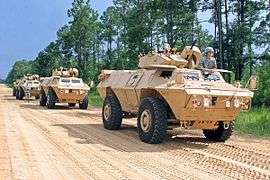
In the 1980s, U.S. military doctrine emphasized two distinct types of equipment. Tanks and infantry fighting vehicles were for frontline combat, and unarmored utility vehicles for transport behind the lines.[6] In 1993, the military had to fight through Mogadishu in unarmored Humvees, leading to the development of up-armored models. Many generals doubted the benefits, but the Military Police Corps, tasked with patrolling the "safe" rear area behind the battle line insisted that the Army fund a slow but steady production of the bullet resistant M1114 Humvee.
In 1999, the United States Army began buying a limited number of M1117s (originally the ASV-150) for the Military Police Corps. This purpose-built ASV was derived from Cadillac Gage's previous Commando family of AFV which was used in Vietnam for base security. The ASV 150 is a much improved version of the earlier Cadillac Gage 100/150, with improved armor protection and better maneuverability due to the use of Timoney's independent suspension system.
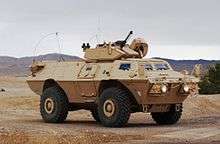
The ASV uses an advanced modular expandable armor package from IBD Deisenroth Engineering, consisting of ceramic composite applique on the exterior and spall liner on the interior. At $800,000 each, the M1117 was significantly more expensive than the $140,000 price for an M1114 and $220,000 (2011) for an armoured M1114.[7] They were field tested by MP units in Kosovo mostly by members of the 709th MP Battalion.[8] The program was canceled in 2002 because of budget priorities. The United States Army believed that existing vehicles could be used without an "unacceptable level of risk."[8] When the Iraq War began in 2003, there were 49 ASVs in service, with almost all of them being assigned to MP Units. The first MP unit to officially use them in a combat zone was the 527th MP Company and other elements of the 720th MP Battalion. However, the onset of events in Iraq gave new life to the ASV program as HMMWVs proved vulnerable to attacks and a large source of casualties. Up-armored HMMWVs were not designed to be armored cars like the M1117, which are designed to withstand hits from small arms, mines and rockets in front-line combat units. Soldiers who used them, and some members of Congress visiting Iraq favored them over other mine protected vehicles. As of mid-2007, 1,729 vehicles were delivered or under contract with many being dispersed not just to MPs but numerous other military units including the Iraqi National Police.
In response to urgent United States Army requirements in the mid-2000s, production increased from one ASV every three weeks to 56 vehicles per month. The plant that produces the vehicles is located in New Orleans and was heavily damaged by Hurricane Katrina. The manufacturing facilities have since been rebuilt and expanded to five buildings and personnel have more than doubled. The vehicle is a 21st-century version of the V-100 Cadillac Gage Commando which was used by the U.S. Army Military Police during the Vietnam War,[9] whose duties often consisted of providing armed escort for wheeled convoys. The USAF in South Vietnam utilized an open hatched (turret-less) Commando for base security missions.[10]
A variant was to be evaluated by the U.S. Marine Corps as part of the Mine Resistant Ambush Protected (MRAP) vehicle program. As of May 18, 2007, after their vehicle submission failed ballistics testing at Aberdeen Proving Ground, Textron received word that they would not receive further orders as part of the MRAP program.[11] However, in early 2008, Textron was awarded a contract to build 329 ASVs worth $228 million. They will be delivered with the latest fragmentation protection kits. The total number of ASVs produced and remaining to be delivered to the U.S. Army is 2,058 vehicles.[12]
Design
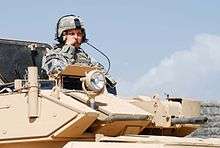
At about 15 tons, the M1117 is lighter than the 20 ton Stryker ICV or 25 ton M2 Bradley armored vehicle. It can reach a speed of 20 miles per hour in 7 seconds.[13] It is only 7 feet 9 1⁄2 inches (2.375 meters) wide, compared to 11 feet 9 1⁄2 inches (3.594 meters) for a Bradley. Buttoned up, the crew has 360° visibility. In size and capability, it fits between the Humvee and the $5 million Stryker. The crew compartment is fully air-conditioned.
Survivability
The Guardian's armor is designed to defeat small arms fire, mines and Improvised Explosive Devices (IEDs). The armor is angled presenting no vertical surfaces, deflecting many rocket-propelled grenade (RPG) hits. If an RPG does hit the vehicle directly, it can still function, although crew survivability varies depending on the location at which the RPG hits.[14] Angled armor is more resistant to attack than vertical armor due to the shape of the V-shape hulls deflecting explosive forces, as opposed to a single-plane hull which takes the entire force impact.
ASVs in Iraq and Afghanistan have withstood several IED attacks, some vehicles multiple times. One ASV returned 28 miles (45 km) after an IED destroyed all four tires. As for chemical and biological attacks, the ASV's gas particulate air filtration system was designed to provide additional protection, but is currently not in service due to lack of crew masks for the system. The ASV has experienced several rollover incidents. Soldiers have a higher survivability rate when rolling over, as the turret is fully enclosed protecting the gunner from ejection. However, there have been at least two incidents of rollovers that resulted in the deaths of two soldiers when the turret broke away from the vehicle.[15][16] Since the incidents, Textron has started adding 15 additional bolts to the vehicle turret.
Mobility
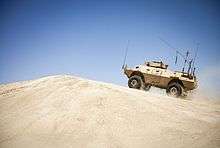
The typical mission profile of an ASV involves 50% travel primary roads, 30% travel on secondary roads, and 20% cross-country travel. It uses a model MD3560 Allison Transmission. Front and rear independent suspension provides smooth highway speeds of up to 70 mph (110 km/h), while it is capable of fording 5-foot (1.5 m) depths of water, climbing gradients of 60%, negotiating 30% side slope, and overcoming obstacles of five feet. Its turning radius is 27.5-foot (8.4 m), and it has 18-inch (46 cm) ground clearance.
Six ASVs can enplane on a C-17, fully loaded and ready to roll off. Also, the CH-53E Super Stallion is able to carry one ASV.
Variants
The following variants are known to be in production/service:[17]
- Command & Control
- Recovery Vehicle (Each ASV can flat tow another ASV or HMMWV)
- Reconnaissance Surveillance & Target Acquisition (RSTA)
- Ambulance
- Infantry Carrier Vehicle (ICV, alternate name for an Armored Personnel Carrier (APC)) – 24 in longer than ASV, armed with cupola mounting for a machine gun or grenade launcher instead of a turret, carries 3 crew and 8 troops.[18]
- M1200 Armored Knight FiST-V
Direct fire support variant
With the adoption of the M1117 as the Mobile Strike Force Vehicle (MSFV) by the Afghan National Army, demand increased for much larger caliber weapons systems mounted on the same chassis which would provide it with an organic anti-tank and fire support capability.[19] On 22 October 2013, a new fire support variant of the M1117 was unveiled at the Association of the United States Army (AUSA) by Textron.[19] This model, described as the Commando Select 90mm Direct Fire Vehicle, was designed with an exceptionally large turret ring and carried a Cockerill Mk III 90mm low-pressure cannon.[19] It provided the M1117 with an extremely potent form of firepower for its size and weight class, firing canister, high explosive, high explosive squash head, and high explosive anti-tank shells, as well as an armour-piercing discarding sabot round capable of destroying older main battle tanks.[20] One advantage of the low-pressure cannon was that, in spite of its relatively large caliber, it could be mounted on a vehicle weighing only 18 metric tonnes, or about 40,000 pounds, combat loaded.[20] The new armament was also fitted with a single-baffle muzzle brake and concentric hydro-spring recoil mechanism as standard to reduce the pressure exerted on the relatively light chassis.[2]
According to Textron, it invested in the 90mm Direct Fire Vehicle as a direct response to the Afghan requirement for a more heavily armed MSFV.[21] Afghanistan immediately ordered 50 and offered to purchase the vehicle through the Foreign Military Sales (FMS) program, with grants from the US government.[22] However, since the 90mm cannon and most of the turret components were made in Belgium, US military officials blocked the sale until they could qualify and approve that particular combination for export through FMS.[22] In 2014, the procurement process was suspended when the US canceled its funding for the sale of almost 300 MSFVs, including the 50 Direct Fire Vehicles, to the Afghan National Army citing budgetary constraints.[23] The US military had not yet finished its testing of the Belgian weapons system at the time, so none were ever delivered.[22] As Kabul's requirement for a fire support variant of the MSFV remained unfulfilled, Textron agreed to revisit the potential sale with Afghan officials in 2017.[22]
Around the same time, Iraq requested an undisclosed number of 90mm Direct Fire Vehicles from Textron for its ongoing campaign against the Islamic State of Iraq and the Levant. The sale was pending review by the US government in February 2017.[24]
Foreign variants
Bulgaria uses a variant of the M1117 APC fitted with a NSVT heavy machine gun instead of the M2. Not all vehicles have been converted this way.
The Iraqi Armored Personnel Carrier ASV variant is configured for transport. The Iraqis also have modified some of their ASVs to accommodate an anti-air turret.
Operators
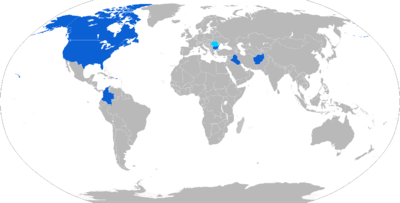
Current operators


.svg.png)



Potential operators
See also
References
- Doyle, David. Cadillac Gage V-100 Commando. 2008, Squadron Signal Publications. ISBN 978-0-89747-574-7.
- http://spioenkop.blogspot.com/search/label/YPG
- "A Commando For Every Mission" (PDF). Providence, Rhode Island: Textron. 2015. Archived from the original (PDF) on 13 December 2016. Retrieved 20 March 2017.
- Lansford, Thomas (2017). Afghanistan at War: From the 18th-Century Durrani Dynasty to the 21st Century: From the 18th-Century Durrani Dynasty to the 21st Century. Santa Barbara: ABC-CLIO, publishers. p. 60. ISBN 978-1-59884-759-8.
- "Army National Guard FY2012 Financial Report" (PDF). Arlington, Virginia: United States Army National Guard. 2012. Archived from the original (PDF) on 1 February 2017. Retrieved 20 March 2017.
- COMMANDO™ Elite - Textron Systems, 7 October 2016
- "New style of war key to success in Iraq". Government Executive. Archived from the original on 6 June 2011. Retrieved 13 February 2015.
- Keyes, Charles (28 January 2011). "Steep cost of military vehicles outlined in Army report". CNN. Retrieved 28 April 2015.
- Safer Vehicles For Soldiers.
- Doyle, p. 2
- Doyle, p. 2, 40
- Textron’s M1117 Removed from MRAP Competition
- Marine & Land Awarded $228 Million for 329 Additional U.S. Army M1117 Armored Security Vehicles. Archived 2011-08-23 at the Wayback Machine
- "M117 Armored Security Vehicle Data Sheet." Textron Marine and Land Systems, 17 May 2011. Web. Retrieved 1 Aug 2012.
- John Pike. "M1117 Armored Security Vehicle (ASV)". Retrieved 13 February 2015.
- Will Higgins (20 July 2008). "Mom looking for answers in Iraq rollover death". Indianapolis Star. Retrieved 28 November 2011.
- Will Higgins. "Army Sgt. Gary M. Henry". Indianapolis Star. Retrieved 28 November 2011.
- "Armoured Security Vehicle (ASV) in demand in Iraq". Retrieved 13 February 2015.
- M1117 ICV - Strategypage.com, February 10, 2013
- Hoarne, Stephen (23 October 2013). "Commando Select 90mm Direct Fire Armored Vehicle Unveiled". Tampa, Florida: Defense Media Network (Faircount Media Group). Archived from the original on 9 October 2016. Retrieved 20 March 2017.
- "Cockerill 90 CSE LP" (PDF). Seraing, Belgium: Cockerill Maintenance & Ingénierie (CMI) Group. 2015. Archived from the original (PDF) on 10 March 2017. Retrieved 20 March 2017.
- Roosevelt, Ann (October 2013). "Expansion and Growth Are Watchwords For Textron Systems, Top Official Says" (PDF). Defense Daily (Access Intelligence, LLC). Rockville, Maryland. Archived from the original (PDF) on 13 April 2017. Retrieved 13 April 2016.
- Fish, Tim (22 February 2017). "IDEX 2017: Textron to develop larger turrets". Shepard Media. London. Archived from the original on 1 March 2017. Retrieved 13 April 2017.
- Smith, Josh (4 July 2016). "U.S. ditched plan to give Afghan forces more armored vehicles". Reuters. London. Archived from the original on 9 July 2016. Retrieved 13 April 2017.
- Binnie, Jeremy (21 February 2017). "IDEX 2017: Iraq takes delivery of Textron Commandos". London: Jane's Information Group. Archived from the original on 23 February 2017. Retrieved 29 March 2017.
- "Archived copy". Archived from the original on 2015-05-18. Retrieved 2015-05-18.CS1 maint: archived copy as title (link)
- https://www.armyrecognition.com/october_2017_global_defense_security_news_industry/textron_will_delivered_255_mobile_strike_force_vehicles_to_afghanistan.html
- "Textron Systems Brand Change". Retrieved 13 February 2015.
- "Archived copy". Archived from the original on 2011-10-25. Retrieved 2011-09-11.CS1 maint: archived copy as title (link)
- Colombian Army Acquires 28 Additional ASV Armored Personnel Carriers - Deagel.com, 22 August 2013
- Ejercito de Colombia recibirá nuevos blindados M1117 Commando Select - webinfomil.com, 4 April 2016
- "Iraqi Army beefs up armored forces". Retrieved 13 February 2015.
- "Ελληνικός Στρατός: Τον Μάρτιο η αποδέσμευση των M-1117 Guardian από το Κογκρέσο, 800 οχήματα σε πρώτη φάση". Defence Review (in Greek). 12 February 2020. Retrieved 18 February 2020.
External links
| Wikimedia Commons has media related to M1117 Guardian Armored Security Vehicle. |